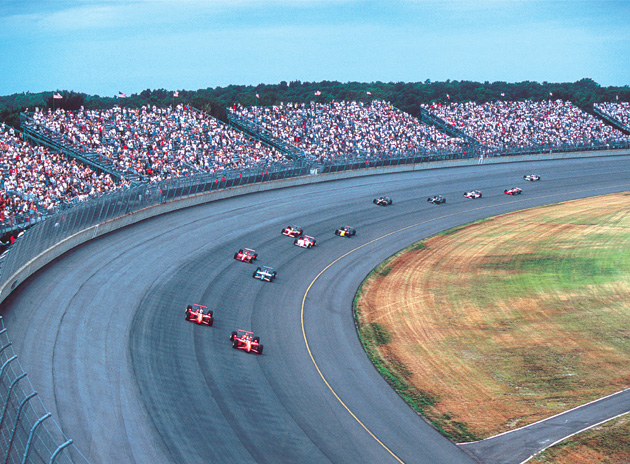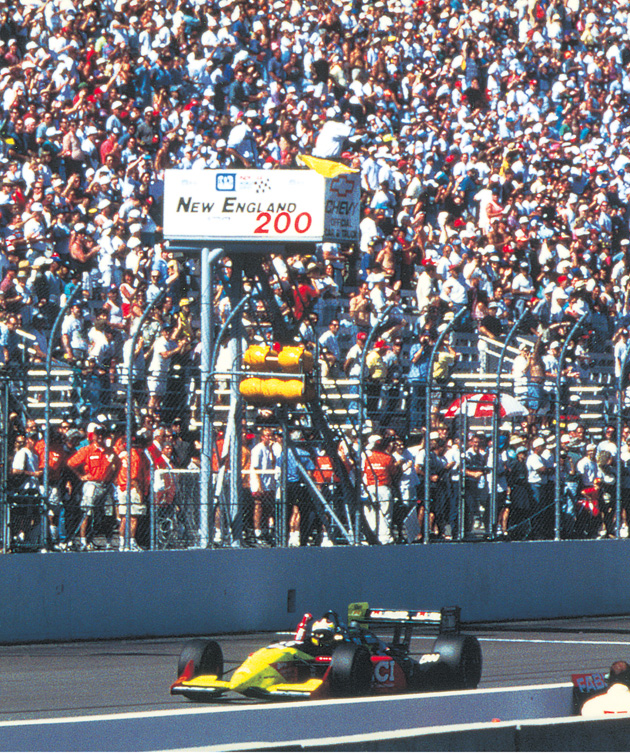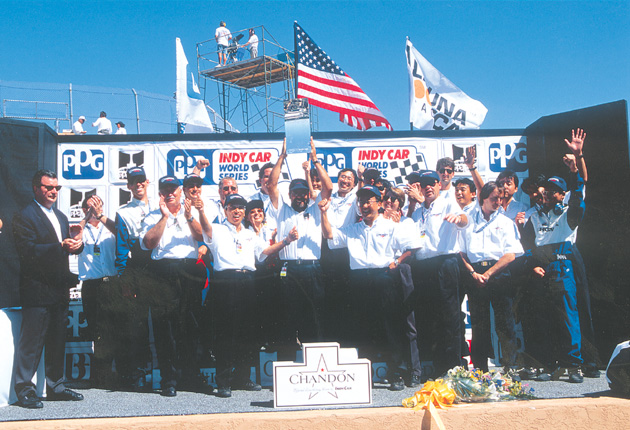Entry to Champ Car Racing / 1994
The Motive Behind the Indy Decision
"Wow, what speed! This is the race where engine performance counts most. If Honda participates in any U.S. racing event, it has to be this one."
Michihiro Asaka, who saw his first Indy 500 race in 1987, was deeply inspired by what he had witnessed. Working for Honda R&D North America (HRA) at the time, Asaka had seen several Indy Car races at Long Beach, California where the cars streak through the city's streets. However, he had never seen a race on an oval course such as the Indy 500, where machines fly at more than 350 km per hour. He was immediately fascinated by the sheer speed of it.

A heated battle was fought on the oval course in Michigan, 1996.
Koichi Amemiya and Tom Elliot, president and executive vice president of American Honda (AH), had envisioned a plan. AH had already implemented various measures to expand its car sales in the U.S., the world's largest market. However, it was not yet involved in any local motor sports events. In Japan Honda was known for its years of involvement in racing, but in America, with its popular Accord and Civic models, Honda was simply thought of as one of many manufacturers of passenger cars. But Amemiya wanted to change that image by demonstrating Honda's strengths in motor sports and the spirit of competition it brought to every race. And at this point Amemiya's desire and Asaka's inspiration found their convergence.
In 1989 Amemiya and Asaka were both watching the Indy 500 race from the stands. Excited, the two found a congenial spirit in each other, each vowing that he would do whatever it took to compete in the race.
The research center in Wako (HGW) soon began a research project devoted to the design and development of a prototype Indy engine. Unfortunately, Honda had been going through difficulties with the F-1 series in which the company was then competing. As a result, the testing of Indy car engines was halted and the Indy project staff members were reassigned to F-1 in order to assist the team.
Asaka was undaunted, however, and saw this turn of events more as an opportunity than a setback. Although engine development had been stopped, there was nothing that kept them from doing the planning. So, Asaka drafted several plans based on Honda's Indy strategy, proceeding with preparations so that development could resume as soon as a go-ahead was given.
Asaka reorganized the development team for the Indy Car racing engine when, in September of 1992, the company announced its temporary withdrawal from F-1. The following January, Amemiya used the occasion of the Detroit Auto Show to announce Honda's plan to enter the PPG Indy Car World Series. Standing there next to Amemiya, Asaka said to himself, "This is the race we do for the American people. As such, I want all employees at American Honda to understand their company's challenging spirit and apply all they will learn from Honda's involvement in the race. This is the principal objective of our entry in the Indy Car series, just as our objective of F-1 competition was the furtherance of engineering skill and knowledge at the research center."
Establishment of HPD
Honda Performance Development (HPD) was set up as a wholly owned subsidiary in April of 1993, with Elliot as president following the official announcement of Honda's entry into Indy competition. The purpose of the new company was to supply engines to the racing team.
HPD's role was to manage the supply of engines to the Honda racing team while serving as a technical center. Moreover, the company was expected to supply to more than one team in the future. At the time, however, AH had no engineer with prior motor sports experience. So, HPD began its quest for Americans with racing experience, sifting through the rosters of current employees at Honda's North American branches and factories. At the same time it recruited applicants through the use of classified advertisements in motor-racing publications.
For its corporate slogan HPD adopted the equation, "Performance + Quality = Success."
Performance, of course, refers to the engines themselves, but it also encompasses the performance of operations such as engine assembly and team support. Quality refers to the satisfaction of every requirement while maintaining the highest possible standards. These include the assurance of engine quality, a guarantee of zero problem occurrences, the timely response to delivery schedules, and outstanding team support. Without these two key components - performance and quality - success is not possible. Without the full power and capabilities of the team as a whole, the customer will not be satisfied and no race will be won.
Pure Excitement: The Indy Car Race
Indy cars as driven on road courses differ little from their F-1 counterparts. However, there are two key differences between Indy and F-1. First, Indy Car racing places greater emphasis on customer satisfaction. Second, the technical standards are very high with Indy cars, particularly because of the CS effort.
Race drivers in the U.S. stay close to their audience. When asked, they'll casually sign autographs, asking the fan's name and writing it down with "Best Wishes" scribbled above it. The signed autograph is then returned to the fan along with a friendly "thank you." The drivers are well aware of their role as entertainers.
The drivers aren't the only ones who feel this way. Race organizers are also excellent promoters. They run Indy Lights and other races before their main event - the fabled Indianapolis 500 - so that the crowds can experience a full day of excitement at the track. Accordingly, the Indy audience covers all age groups and backgrounds, including young children and senior citizens. Of course, no motor sports event can survive, let alone prosper, without the support of its fans. This goes back to the essence of customer service: Always keep the audience in mind.
This customer-oriented thinking pushes the technical standards as well, for in addition to mastering a diversity of challenging courses the racing teams must meet many other conditions. For example, in order to make the race more interesting, the use of semiautomatic transmissions and automatic power steering is prohibited. This also serves to control costs and level the playing field for all machines entered. There are also restrictions on engine materials, valve-gear systems and variable-speed mechanisms. To enhance performance, a team must develop new technologies to overcome the limitations.
Qualifying races are as a result usually very close battles, with fifteen to twenty cars finishing within a mere second of each other. A delay of one-tenth of a second could mean the difference between the pole position and 20th. And all this is simply a lead-up to the final race, where skillful maneuvering and frequent passing serve to increase the audience's excitement.
Indy, however, is subject to more technological restrictions than F-1. Therefore the challenges are presented on a different level, since each team must find ways to outperform the others within a tightly defined set of limitations.
Before the Start: Leaping a Hurdle
Because of Indy's focus on customer satisfaction, the news of Honda's entry sent shock waves through the CART* industry. No doubt they feared that Honda might shake up the CART community with another string of victories, as it had in F-1. Therefore, immediately following the announcement of Honda's entry into Indy competition for the 1993 season, the industry unveiled a series of rules that were decidedly to Honda's disadvantage. In the technical area, the variable-speed mechanism, air valve and other technologies that Honda had used in F-1 were prohibited, down to the most minute detail. In addition, a new rule was established requiring a new engine manufacturer to supply three or more machines to two teams for the first year and six or more machines to three teams during the second year.
The rule was a great blow to Honda, which had planned to start with one team and one driver: Rahal Hogan Racing and its star competitor, Bobby Rahal.
Since the organizers would not bend the rules, Honda once thought of giving up Indy altogether. However, Honda signed Comtech Racing Team as its second unit, in the process securing three drivers. Honda finally saw the light of day when race organizers allowed the teams to compete in four or five races using Honda engines.
"Honda's F-1 achievement was not received well by the Indy community," says Asaka. "That's why it took us longer than expected to get onto the circuit. Technical difficulties can be solved at the research center, but political problems must be resolved through face-to-face negotiations with Indy officials."
Note:
CART (Championship Auto Racing Teams) is the organizing body for what was then known as the Indy Car Racing.
The Humiliating '94 Series
In March of 1994, after overcoming these hurdles and drawing the media's attention each step of the way, Honda made its debut. But to the disappointment of the audience, Honda ended its inaugural season with humiliating results. Its engines finished thirteen out of sixteen races yet produced merely one podium win. Particularly, the race that made clear to Honda the high standard of Indy Car racing was the Indy 500, the same race that had seven years earlier inspired Asaka to decide it was the race for Honda. The 500 is, of course, the original and longest-running race in the Indy Car series.

In the first event of the 1994 PPG Indy Car World Series, Honda's debut, team driver Bobby Rahal was involved in a crash on the first lap, which forced him to retire from the event.
Rahal Hogan Racing, which had in its qualifying round lost out of the Indy 500, decided to use a chassis and Ilmore engine supplied by another team.
Following that, Asaka received a fax from Rahal Hogan immediately before the 11th running of the Mid-Ohio race, saying they would terminate their contract with Honda as of the end of the season. Asaka could not conceal his shock at such sudden, unexpected notice from Bobby Rahal, who since 1989 had been supplying information to Honda and actively cooperating with testing, even prior to Honda's announcement that it would compete in Indy.
Honda was brought back to attention by this embarrassing experience, a fact that ultimately led to the new HRH engine. The HRX engine used during the 1994 season had employed a cast-iron block to ensure sufficient durability for the 500-mile run. However, the development team, which was working hard to improve the HRX engine, decided to tackle a seemingly impossible task. They would continue working on the HRX for the upcoming races while developing a new engine. The HRH unit adopted an aluminum block for reduced overall weight. In collaboration with Comtech Racing Team, a series of tests was conducted.
A Sure Sign of Success
In 1995, Honda's second year in the Indy Car series, it decided it would supply to Tasman Motorsports. Tasman was a team on the rise, having already won two consecutive championship titles in the Indy Lights category. With rookie driver Andre Ribeiro as its prime weapon, the team was filled with the fighting spirit. Honda, Tasman and Ribeiro were united under the same goal: to take on the older, more seasoned teams.
Honda decided on the Indy 500 for the debut of its HRH engine, which had been under development since the fall of 1994. Honda wanted desperately to win that race, hoping to realize its dream of victory and restore its team members to the level of morale they deserved. And of course it was a golden opportunity to test the new engine.
The decision came not without considerable risk. However, the team members were very confident in their ability to achieve the seemingly impossible feat of completing the Indy 500 with a new engine. The HRH engine had been repeatedly tested at Indianapolis Motor Speedway to ensure that it would have a sufficient blend of power, speed and durability.
May 13, 1995, was the day of the official qualifying rounds for the Indy 500. And at the end of the day at the speedway: a Tasman Motorsports machine equipped with an HRH engine driven by Scott Goodyear, lined up in the front row (at the third grid) facing the starting line. In the qualifying rounds, the results of four laps are combined and tabulated to determine the starting grid for the final race. Since the machines are driven under acceleration to full speed, engine power counts most during these short races. But at last the exhaustive effort that had begun in the fall of 1994 was about to be rewarded. Taking photogra-phs alongside their car in the front row, the staff experienced the welling of tears that accompanies one's best wishes for a true friend.
Then, in the 1995 Indy 500 race May 28, Scott Goodyear pulled off an impressive performance, leading all the way up to the last few laps. However, he inadvertently passed the pace car just before the goal and received a penalty. As a result, he finished in 14th place. Describing what he saw that day, Asaka said, We won the battle, but lost the race.
Efforts to improve the HRH engine continued after the race. Then, in the 15th event of the 1995 season, on the circuit at New Hampshire, Andre Ribeiro drove his Honda-powered car to victory - a long-awaited first win for Honda. Contributing to the victory was the advice given to Ribeiro by the team's chief engineer, Kazutoshi Nishizawa, who said, "You can save time by downshifting just before the turn, where the r.p.m. drops, to take full advantage of the Honda engine's high revs and output."
Victory had finally arrived, in the 31st race since Honda's debut in March, 1994.

Honda won its long-awaited first victory in 1995 at the 15th race, which was held in New Hampshire. Andre Ribeiro's machine took the checkered flag before a huge audience of fans.
A Triple Champion: What Would Be Next?
Honda's goal for the third year was the championship title. Following the U.S. 500 of the 1995 season, the number of teams wanting to use Honda engines increased significantly, and as a result Honda became a supplier to four teams, for a total of six machines during the 1996 season.
The first race of the season, where Honda scored an impressive one-two finish, was a sign of the great strides Honda was to make in the 1996 season. Launching into the year with four straight victories, Honda eventually won eleven out of sixteen races, including the U.S. 500. The results were enough to give Honda triple honors: the Manufacturers Championship title, the PPG Cup Championship title for driver Jimmy Vasser and the Rookie of the Year award for driver Alex Zanardi.

Honda won triple victories in 1996, after only three seasons in the Indy-CART series. Here the Honda staff members congratulate each other on their impressive season.
Honda's victorious season was a top news story the day following the final race, with the national newspaper USA Today proclaiming the achievement in a large headline on its second page. Sales were then boosted through the use of a well-timed promotional campaign in which the winning machine was displayed at dealerships.
The number of dealers and employees who have come to the circuit to cheer their teams has risen steadily year after year, offering proof that many who work for Honda in the U.S. have come to know and appreciate the extent of the company's competitive spirit.
Vasser, who won the PPG Cup Championship in 1996, said "Honda puts forth its best effort, down to the minor details, in order to achieve success. They never compromise on anything when it comes to winning."

Team members surround Jimmy Vasser, winner of the 1996 U.S. 500 with a Honda-powered car.
The views of project team members, on the other hand, are somewhat different. "Although it's a competition, we learned that we must not neglect the element of customer satisfaction in racing," said one engineer.
Honda's competitive spirit, born and nurtured in Japan, has indeed crossed the ocean intact. In the U.S. it has prospered, taking root within the popular racing culture.
In 1998, Honda repeated its "triple crown" earning the Manufacturers Championship by winning thirteen of nineteen races, while driver Alex Zanardi won his second PPG Cup trophy as the top driver (for the second straight year) and Tony Kanaan won the Rookie of the year award.
Says Asaka of the company's involvement in U.S. CART series, "I want HPD to become the champion of Honda's competitive spirit. I want it to be an organization that reminds people of the vision of our Old Man, Soichiro Honda."